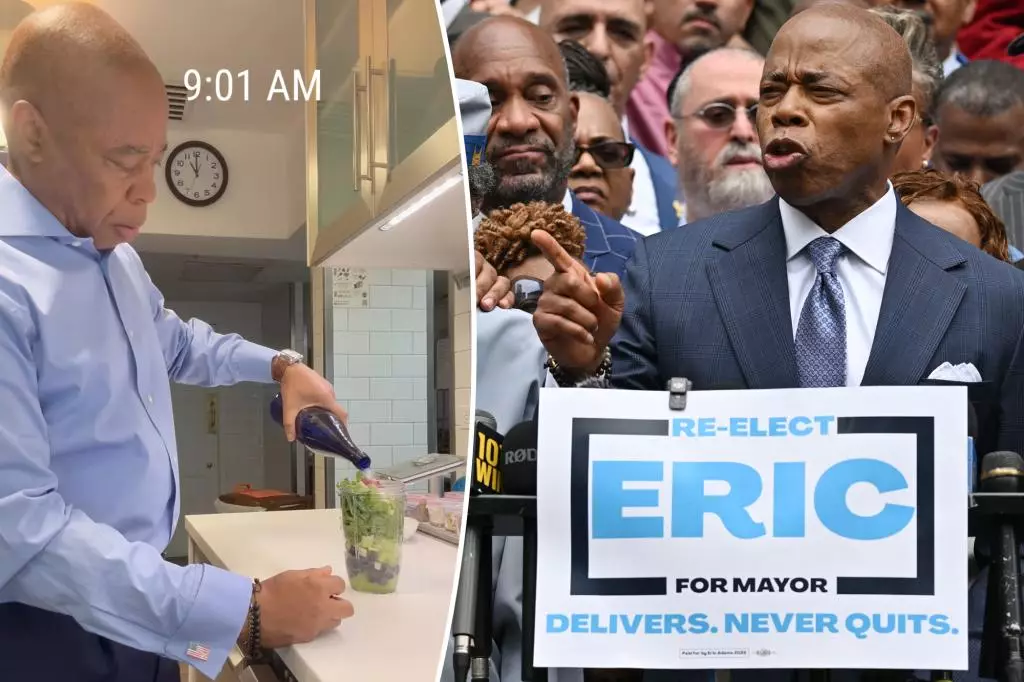In an era when political campaigns often feel stale and disconnected, New York Mayor Eric Adams has boldly reinvented himself as a genuine social media influencer. Rather than adhering to the usual scripted speeches and formal appearances expected of politicians, Adams has embraced a fresh, relatable digital persona that bridges the gap between elected officials and everyday citizens. His foray into content types typically reserved for TikTok stars—such as “get ready with me” (GRWM) videos, smoothie-making tutorials, and candid “day in the life” glimpses—illustrates an innovative approach to political communication designed to resonate on a more human level.
This strategy diverges from the norm in a way that intelligently leverages modern social media trends without appearing forced. Rather than simply posting polished campaign ads, Adams invites his followers into moments often dismissed as mundane, such as ironing his own clothes. Ironically, this has become a surprisingly viral point of engagement, with pedestrians allegedly stopping him to marvel at his commitment to “crisp” attire. Such ordinary acts deftly dismantle the barrier between politician and constituent, underscoring Adams’s commitment to authenticity in a profession too often characterized by guardedness.
Direct Communication Amid Legacy Media Fatigue
Adams’s pivot toward social media content is also a pragmatic acknowledgment of changing media dynamics. His own words reveal a frustration with traditional news outlets, which he suggests have sidelined his campaign coverage. Streaming platforms and social networks offer a direct channel to voters, bypassing gatekeepers and allowing Adams to tell his story unfiltered. He recognizes the “game” that social media represents and—rather than resisting it—embraces it fully, understanding that effectiveness requires more than dipping a toe into these platforms.
By transforming from “Mayor Adams” to “Hizz-influencer” (as some cheekily dub him), he not only reaches younger and more digitally attuned demographics, but cultivates an approachable image. This approach illustrates a savvy recognition: voters today seek not only policies but palpable connection and relatability. By showing “good days and bad days,” Adams humanizes himself and pushes back against the polished yet impersonal political archetype.
Authenticity as a Political Asset—or a Calculated Risk?
The mayor’s candidness—smoking cigars, drinking bourbon, sharing personal quirks—represents a bold gambit. Politicians often tightly control public impressions, fearing that any deviation from a squeaky-clean image may be weaponized. Adams flips this on its head, positing that revealing imperfections and relaxed authenticity fosters trust. While this strategy seems progressive and refreshing, it carries inherent risks. Oversharing or appearing too casual could alienate certain voters who expect traditional decorum from their leaders.
Yet Adams appears willing to take this chance in order to cultivate a multifaceted identity that transcends the expected “suit and tie.” The approach seems to reflect a broader societal trend valuing transparency and realness, even in high-stakes, professional contexts historically dominated by image management. Whether Adams’s experiment will shift political communications more broadly or remain a personal quirk remains to be seen, but it certainly sets a precedent for other politicians craving renewed charisma.
Facing Past Controversies with Resilience
Beyond his influencer persona, Adams confronts a darker chapter in his political journey with measured defiance. His remarks about being targeted in a federal bribery and corruption indictment—subsequently pardoned by former President Donald Trump—highlight the complexity underlying his public image. Instead of evading these issues, Adams addresses them head-on, denying any wrongdoing and emphasizing that people around him acted improperly. This candidness further complements his transparent social media approach and challenges the simplistic narratives often spun by politics or media opponents.
Interestingly, while deflecting direct political allegiance, Adams remains open to endorsements that advance his central message: moving New York City forward. This suggests a strategic flexibility designed to appeal broadly, even in an increasingly polarized landscape. His willingness to consider support across political divides, alongside his unorthodox social media campaign style, illustrates an adaptive leadership style rooted in pragmatism rather than rigid ideology.
Reimagining Political Engagement for a New Generation
Ultimately, Eric Adams’s melding of influencer culture with mayoral responsibilities embodies one of the most compelling experiments in contemporary political branding. By embracing vulnerabilities, leveraging modern communication channels, and rejecting stale formulas, he attempts to transform not only his own political narrative but how voters engage with elected officials. This approach challenges the entrenched norms of political communication and sets a new benchmark for leaders navigating the digital age.
Whether Adams’s social media charisma will translate into sustained political success or fade as a gimmick remains uncertain. However, his acknowledgment that “social media is the game” signals an essential truth for modern politicians: power today increasingly resides in the ability to authentically connect with people beyond podiums and press releases. Through his irons, smoothies, cigars, and candid reflections, Adams is staging a compelling case for embracing humanity in leadership—something far too rare in politics and much needed in this moment.

